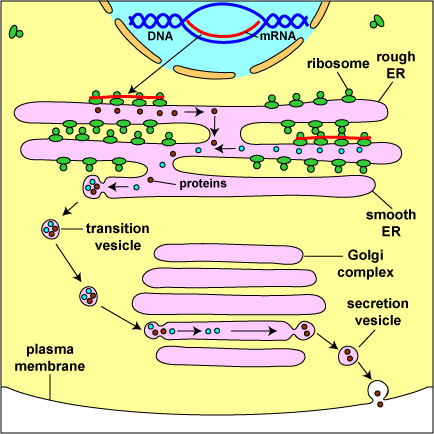
The genes in the DNA are transcribed into mRNA molecules that enter the cytoplasm through pores in the nuclear membrane. Ribosomal subunits attach to the mRNA molecules and the genetic message is translated into protein. Ribosomes attached to mRNA molecules coding for proteins to be secreted from the cell or enter lysosomes attach to receptors on the endoplasmic reticulum (ER). These proteins then enter the lumen of the ER where they can be transported elswhere within the ER. The proteins typically enter the smooth endoplasmic reticulum where they are placed in transition vesicles. The transition vesicles fuse with the Golgi complex where the proteins may be modified, sorted, and placed in secretion vesicles. The secretion vesicles, in turn, fuse with the cytoplasmic membrane releasing the proteins from the cell.
Illustration of the Role of the Endoplasmic Reticulum and Golgi Apparatus in the Movement of Molecules within and from Eukaryotic Cells by Gary E. Kaiser, Ph.D.
Professor of Microbiology,
The Community College of Baltimore County, Catonsville Campus
This work is licensed under a Creative Commons Attribution 4.0 International License.
Based on a work at https://cwoer.ccbcmd.edu/science/microbiology/index_gos.html.
Last updated: August, 2019
Please send comments and inquiries to Dr.
Gary Kaiser